Wenchao Chen
Member, IEEE
Duplex: Dual Prototype Learning for Compositional Zero-Shot Learning
Jan 13, 2025



Abstract:Compositional Zero-Shot Learning (CZSL) aims to enable models to recognize novel compositions of visual states and objects that were absent during training. Existing methods predominantly focus on learning semantic representations of seen compositions but often fail to disentangle the independent features of states and objects in images, thereby limiting their ability to generalize to unseen compositions. To address this challenge, we propose Duplex, a novel dual-prototype learning method that integrates semantic and visual prototypes through a carefully designed dual-branch architecture, enabling effective representation learning for compositional tasks. Duplex utilizes a Graph Neural Network (GNN) to adaptively update visual prototypes, capturing complex interactions between states and objects. Additionally, it leverages the strong visual-semantic alignment of pre-trained Vision-Language Models (VLMs) and employs a multi-path architecture combined with prompt engineering to align image and text representations, ensuring robust generalization. Extensive experiments on three benchmark datasets demonstrate that Duplex outperforms state-of-the-art methods in both closed-world and open-world settings.
MaskMamba: A Hybrid Mamba-Transformer Model for Masked Image Generation
Sep 30, 2024Abstract:Image generation models have encountered challenges related to scalability and quadratic complexity, primarily due to the reliance on Transformer-based backbones. In this study, we introduce MaskMamba, a novel hybrid model that combines Mamba and Transformer architectures, utilizing Masked Image Modeling for non-autoregressive image synthesis. We meticulously redesign the bidirectional Mamba architecture by implementing two key modifications: (1) replacing causal convolutions with standard convolutions to better capture global context, and (2) utilizing concatenation instead of multiplication, which significantly boosts performance while accelerating inference speed. Additionally, we explore various hybrid schemes of MaskMamba, including both serial and grouped parallel arrangements. Furthermore, we incorporate an in-context condition that allows our model to perform both class-to-image and text-to-image generation tasks. Our MaskMamba outperforms Mamba-based and Transformer-based models in generation quality. Notably, it achieves a remarkable $54.44\%$ improvement in inference speed at a resolution of $2048\times 2048$ over Transformer.
Treating Brain-inspired Memories as Priors for Diffusion Model to Forecast Multivariate Time Series
Sep 27, 2024Abstract:Forecasting Multivariate Time Series (MTS) involves significant challenges in various application domains. One immediate challenge is modeling temporal patterns with the finite length of the input. These temporal patterns usually involve periodic and sudden events that recur across different channels. To better capture temporal patterns, we get inspiration from humans' memory mechanisms and propose a channel-shared, brain-inspired memory module for MTS. Specifically, brain-inspired memory comprises semantic and episodic memory, where the former is used to capture general patterns, such as periodic events, and the latter is employed to capture special patterns, such as sudden events, respectively. Meanwhile, we design corresponding recall and update mechanisms to better utilize these patterns. Furthermore, acknowledging the capacity of diffusion models to leverage memory as a prior, we present a brain-inspired memory-augmented diffusion model. This innovative model retrieves relevant memories for different channels, utilizing them as distinct priors for MTS predictions. This incorporation significantly enhances the accuracy and robustness of predictions. Experimental results on eight datasets consistently validate the superiority of our approach in capturing and leveraging diverse recurrent temporal patterns across different channels.
LVOS: A Benchmark for Large-scale Long-term Video Object Segmentation
May 01, 2024
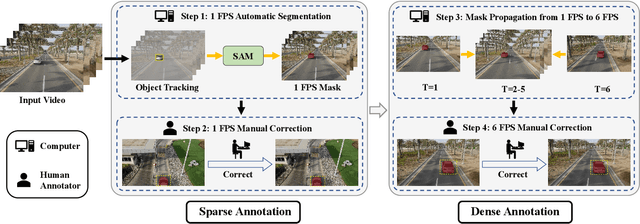
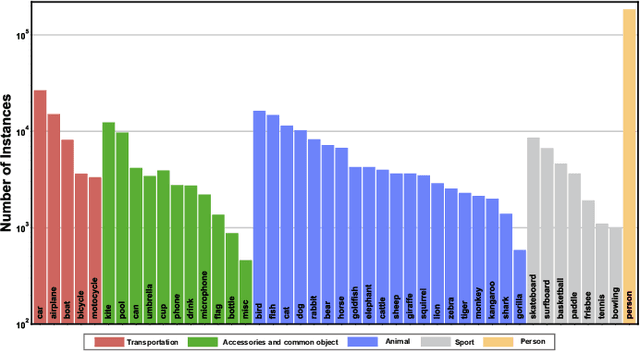

Abstract:Video object segmentation (VOS) aims to distinguish and track target objects in a video. Despite the excellent performance achieved by off-the-shell VOS models, existing VOS benchmarks mainly focus on short-term videos lasting about 5 seconds, where objects remain visible most of the time. However, these benchmarks poorly represent practical applications, and the absence of long-term datasets restricts further investigation of VOS in realistic scenarios. Thus, we propose a novel benchmark named LVOS, comprising 720 videos with 296,401 frames and 407,945 high-quality annotations. Videos in LVOS last 1.14 minutes on average, approximately 5 times longer than videos in existing datasets. Each video includes various attributes, especially challenges deriving from the wild, such as long-term reappearing and cross-temporal similar objects. Compared to previous benchmarks, our LVOS better reflects VOS models' performance in real scenarios. Based on LVOS, we evaluate 20 existing VOS models under 4 different settings and conduct a comprehensive analysis. On LVOS, these models suffer a large performance drop, highlighting the challenge of achieving precise tracking and segmentation in real-world scenarios. Attribute-based analysis indicates that key factor to accuracy decline is the increased video length, emphasizing LVOS's crucial role. We hope our LVOS can advance development of VOS in real scenes. Data and code are available at https://lingyihongfd.github.io/lvos.github.io/.
Considering Nonstationary within Multivariate Time Series with Variational Hierarchical Transformer for Forecasting
Mar 08, 2024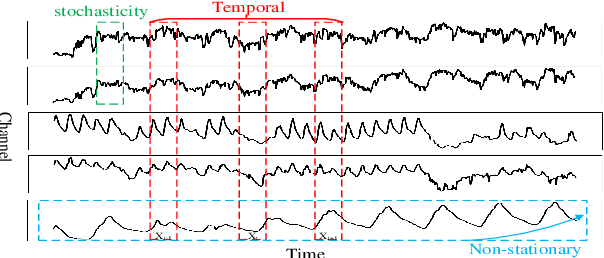
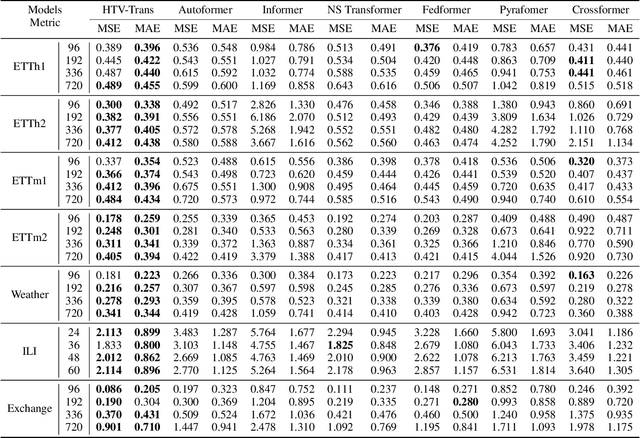
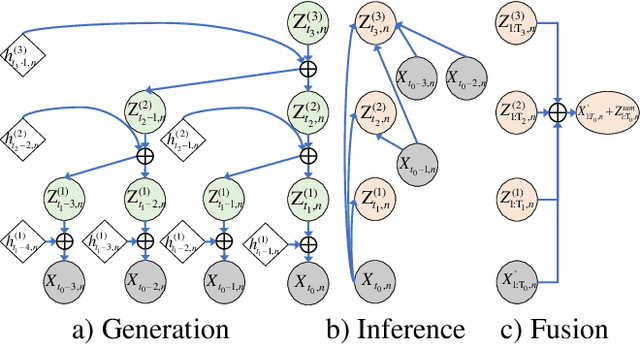

Abstract:The forecasting of Multivariate Time Series (MTS) has long been an important but challenging task. Due to the non-stationary problem across long-distance time steps, previous studies primarily adopt stationarization method to attenuate the non-stationary problem of the original series for better predictability. However, existing methods always adopt the stationarized series, which ignores the inherent non-stationarity, and has difficulty in modeling MTS with complex distributions due to the lack of stochasticity. To tackle these problems, we first develop a powerful hierarchical probabilistic generative module to consider the non-stationarity and stochastic characteristics within MTS, and then combine it with transformer for a well-defined variational generative dynamic model named Hierarchical Time series Variational Transformer (HTV-Trans), which recovers the intrinsic non-stationary information into temporal dependencies. Being a powerful probabilistic model, HTV-Trans is utilized to learn expressive representations of MTS and applied to forecasting tasks. Extensive experiments on diverse datasets show the efficiency of HTV-Trans on MTS forecasting tasks
PanoVOS: Bridging Non-panoramic and Panoramic Views with Transformer for Video Segmentation
Sep 22, 2023Abstract:Panoramic videos contain richer spatial information and have attracted tremendous amounts of attention due to their exceptional experience in some fields such as autonomous driving and virtual reality. However, existing datasets for video segmentation only focus on conventional planar images. To address the challenge, in this paper, we present a panoramic video dataset, PanoVOS. The dataset provides 150 videos with high video resolutions and diverse motions. To quantify the domain gap between 2D planar videos and panoramic videos, we evaluate 15 off-the-shelf video object segmentation (VOS) models on PanoVOS. Through error analysis, we found that all of them fail to tackle pixel-level content discontinues of panoramic videos. Thus, we present a Panoramic Space Consistency Transformer (PSCFormer), which can effectively utilize the semantic boundary information of the previous frame for pixel-level matching with the current frame. Extensive experiments demonstrate that compared with the previous SOTA models, our PSCFormer network exhibits a great advantage in terms of segmentation results under the panoramic setting. Our dataset poses new challenges in panoramic VOS and we hope that our PanoVOS can advance the development of panoramic segmentation/tracking.
Prototypes-oriented Transductive Few-shot Learning with Conditional Transport
Aug 06, 2023Abstract:Transductive Few-Shot Learning (TFSL) has recently attracted increasing attention since it typically outperforms its inductive peer by leveraging statistics of query samples. However, previous TFSL methods usually encode uniform prior that all the classes within query samples are equally likely, which is biased in imbalanced TFSL and causes severe performance degradation. Given this pivotal issue, in this work, we propose a novel Conditional Transport (CT) based imbalanced TFSL model called {\textbf P}rototypes-oriented {\textbf U}nbiased {\textbf T}ransfer {\textbf M}odel (PUTM) to fully exploit unbiased statistics of imbalanced query samples, which employs forward and backward navigators as transport matrices to balance the prior of query samples per class between uniform and adaptive data-driven distributions. For efficiently transferring statistics learned by CT, we further derive a closed form solution to refine prototypes based on MAP given the learned navigators. The above two steps of discovering and transferring unbiased statistics follow an iterative manner, formulating our EM-based solver. Experimental results on four standard benchmarks including miniImageNet, tieredImageNet, CUB, and CIFAR-FS demonstrate superiority of our model in class-imbalanced generalization.
Referred by Multi-Modality: A Unified Temporal Transformer for Video Object Segmentation
May 25, 2023Abstract:Recently, video object segmentation (VOS) referred by multi-modal signals, e.g., language and audio, has evoked increasing attention in both industry and academia. It is challenging for exploring the semantic alignment within modalities and the visual correspondence across frames. However, existing methods adopt separate network architectures for different modalities, and neglect the inter-frame temporal interaction with references. In this paper, we propose MUTR, a Multi-modal Unified Temporal transformer for Referring video object segmentation. With a unified framework for the first time, MUTR adopts a DETR-style transformer and is capable of segmenting video objects designated by either text or audio reference. Specifically, we introduce two strategies to fully explore the temporal relations between videos and multi-modal signals. Firstly, for low-level temporal aggregation before the transformer, we enable the multi-modal references to capture multi-scale visual cues from consecutive video frames. This effectively endows the text or audio signals with temporal knowledge and boosts the semantic alignment between modalities. Secondly, for high-level temporal interaction after the transformer, we conduct inter-frame feature communication for different object embeddings, contributing to better object-wise correspondence for tracking along the video. On Ref-YouTube-VOS and AVSBench datasets with respective text and audio references, MUTR achieves +4.2% and +4.2% J&F improvements to state-of-the-art methods, demonstrating our significance for unified multi-modal VOS. Code is released at https://github.com/OpenGVLab/MUTR.
LVOS: A Benchmark for Long-term Video Object Segmentation
Nov 18, 2022Abstract:Existing video object segmentation (VOS) benchmarks focus on short-term videos which just last about 3-5 seconds and where objects are visible most of the time. These videos are poorly representative of practical applications, and the absence of long-term datasets restricts further investigation of VOS on the application in realistic scenarios. So, in this paper, we present a new benchmark dataset and evaluation methodology named LVOS, which consists of 220 videos with a total duration of 421 minutes. To the best of our knowledge, LVOS is the first densely annotated long-term VOS dataset. The videos in our LVOS last 1.59 minutes on average, which is 20 times longer than videos in existing VOS datasets. Each video includes various attributes, especially challenges deriving from the wild, such as long-term reappearing and cross-temporal similar objeccts. Moreover, we provide additional language descriptions to encourage the exploration of integrating linguistic and visual features for video object segmentation. Based on LVOS, we assess existing video object segmentation algorithms and propose a Diverse Dynamic Memory network (DDMemory) that consists of three complementary memory banks to exploit temporal information adequately. The experiment results demonstrate the strength and weaknesses of prior methods, pointing promising directions for further study. Our objective is to provide the community with a large and varied benchmark to boost the advancement of long-term VOS. Data and code are available at \url{https://lingyihongfd.github.io/lvos.github.io/}.
Sawtooth Factorial Topic Embeddings Guided Gamma Belief Network
Jun 30, 2021



Abstract:Hierarchical topic models such as the gamma belief network (GBN) have delivered promising results in mining multi-layer document representations and discovering interpretable topic taxonomies. However, they often assume in the prior that the topics at each layer are independently drawn from the Dirichlet distribution, ignoring the dependencies between the topics both at the same layer and across different layers. To relax this assumption, we propose sawtooth factorial topic embedding guided GBN, a deep generative model of documents that captures the dependencies and semantic similarities between the topics in the embedding space. Specifically, both the words and topics are represented as embedding vectors of the same dimension. The topic matrix at a layer is factorized into the product of a factor loading matrix and a topic embedding matrix, the transpose of which is set as the factor loading matrix of the layer above. Repeating this particular type of factorization, which shares components between adjacent layers, leads to a structure referred to as sawtooth factorization. An auto-encoding variational inference network is constructed to optimize the model parameter via stochastic gradient descent. Experiments on big corpora show that our models outperform other neural topic models on extracting deeper interpretable topics and deriving better document representations.
 Add to Chrome
Add to Chrome Add to Firefox
Add to Firefox Add to Edge
Add to Edge